Othering The Minority: Comparative Study of Papua in Indonesia’s New Order Era and Rohingya in Myanmar during Military Junta
Keywords:
othering, comparative politics, Myanmar, Indonesia, military ruleAbstract
The paper examines the comparative study of subaltern between Papua in Indonesia’s New Order era and Rohingya in Myanmar during military rule. In Indonesia, Papuan case is an example of how the centralistic military regime treats Papuan ethnic as an object and treat them as “the others” rather than considers them as a part of “Indonesian entity” as the subject itself. Meanwhile in Myanmar, Rohingya case is an example of how centralistic military junta regime treats Rohingya ethnic as “the others” and considers them as foreigners in Myanmar. This paper found a significant difference between the treatment of Indonesian military regime towards Papuan ethnic and the treatment of Myanmar military junta regime towards Rohingya ethnic. In Indonesia, the military regime acknowledges Papuan as a citizen of Indonesia. However, the regime considers Papuan as the “different other” nonetheless. Their different race and ethnicity from Java and Malay ethnic as the majority ethnic are not the subject of the cause, yet it is caused by Papuan traditional behavior which is regarded as “backward” as by the central regime. Meanwhile in Myanmar, since the enforcement of citizenship law in 1982, the military regime clearly does not acknowledge Rohingya from the state citizenship because of their identities, such as religion and Rohingya historical background.
References
Anonmymous, (2000), Historical Background, Retreived, September 2018 from https://www. hrw.org/reports/2000/burma/burm005-01. htm
Anonymous, (2009) “Papua Butuh Bukti Nyata Otonomi Khusus” KOMPAS Newspaper, 18 November 2009
BBC News. (2013). Aung San Suu Kyi’s ‘Attacks on Muslims not Ethnic Cleansing’ – BBC News. [Video File]. Retrieved October 14 from https://www.youtube.com/watch?v=rNVE_ Ch_Q18&t=133s
Crouch, H (1986). Militer dan Politik Indonesia. Jakarta: PT Surya Usaha Ningtias.
Devi, K.S. (2014). Myanmar under The Military Rule 1962-1988. International Research Journal of Science, 3(10), 46-50.
Fatah, E. S. (1994). Negara Orde Baru dan Pengendalian Konflik Politik 1967-1988: Studi Terhadap Peristiwa Malari, Petisi 50, dan Tanjung Priok. Jakarta: Rosdakarya Bandung.
Human Rights Watch (1996). Burma: The Rohingya Muslims: Ending a Cycle of Exodus? Retrieved, October 8 , 2018 from http://www.refworld. org/docid/3ae6a84a2.html
Kusumah, A.R. (2010). Kajian Mengenai Status Failed States Negara Myanmar era pemerintahan Junta militer (1962-2010). Depok: Unpublished Thesis of Universitas Indonesia.
Lewa, C. (2012). North Arakan: An Open Prison for The Rohingya in Burma. Forced Migration Review.
Louai, E.H. (2011). Retracing the concept of Subaltern from Gramsci to Spivak: Historical Development and New Application. Morocco: Department of English Studies, Ibn-Zohr University Agadir.
Ludden, D. (2003). Reading Subaltern Studies: Critical History, Contested Meaning and The Globalisation of South Asia. Delhi: Permanent Black.
Meixler, E. (2018). How the failed democracy uprising Set the Stage of Myanmar’s Future. Retreived, September, 2018 from https:// time.com/5360637/myanmar-8888-uprising-30-anniversary-democracy/
Meteray, B. (2012). Nasionalisme Ganda Orang Papua. Jakarta: Penerbit Buku Kompas.
Myoe, M.A. (2009). Building The Tatmadaw: Myanmar Armed Forces Since 1948. Singapore: Institute of Southeast Asian Studies.
Sen, K & Hill, D. (2000). Media, Culture, and Politics in Indonesia. Melbourne: Oxford University Press.
Silverstein, J. (1977). Burma: Military Rule and the Politics of Stagnation. New York: Cornell University Press.
Spivak, G, C. (1988). Can The Subaltern Speak?. In C. Nelson, and L. Grossberg (Eds.), Marxism and The Interpretation of Culture (pp.271-313). Macmillan Education: Basingstoke.
Steinberg, D, I. (1981). Burma’s Road toward Development: Growth and Ideology under Military Rule. Boulder: Westview Press.
Stszak J,F. (2008). Other/otherness. In Kitchin & Thrift. International Encyclopedia of Human Geography: A 12-Volume Set. Oxford: Elsevier Science
Sundhaussen, U. (1995). Indonesia’s New Order: A Model For Myanmar. Asian Survey, 35 (8), 760-780.
Supriyono, J. (2012). Menarik Batas: Reproduksi Modernitas dan Resistensi Orang Mee terhadap pendatang dan Negara. Depok: Unpublished Thesis of Universitas Indonesia.
Supriyono, J. (2014). Diskursus Kolonialistik Dalam Pembangunan Di Papua. Jurnal Ultima Humaniora, 2(1), 59-78
United Nations, (1948). Universal Declaration of Human Rights Retreived, September 2018 from http://www.un.org/en/documents/udhr/
Vogt, B. (2014). The Path To Civilian Rule in Burma Goes Through Indonesia. Washington DC: Center For National Policy C Truman National Security Project.
Zan M. (2000). Misremembrance of an Uprising. Newcastle Law Review, 4(2), 101-119
Johanes Supriyono, Anthropologist Specialized in Papua issues, May 11, 2016
Downloads
Published
Issue
Section
License

This work is licensed under a Creative Commons Attribution-ShareAlike 4.0 International License.
Authors who publish with this journal agree to the following terms:
1. Authors retain copyright and grant the journal right of first publication with the work simultaneously licensed under an Attribution-ShareAlike 4.0 International (CC BY-SA 4.0) license. This license allows others to remix, adapt, and build upon the work, as long as they credit the author and license their new creations under the same terms.
2. Authors may enter into separate, additional contractual arrangements for the non-exclusive distribution of the journal’s published version of the work (e.g., posting it to an institutional repository or including it in a book), provided there is an acknowledgment of its initial publication in this journal.
3. Authors are permitted and encouraged to post their work online (e.g., in institutional repositories or on their personal website) prior to and during the submission process, as this can lead to productive exchanges and increase citations of the published work (See The Effect of Open Access ).


















